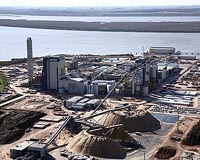| . |  |
. |
Newark DE (SPX) Sep 16, 2009 A chemical reaction can occur in the blink of an eye. Thanks to a new analytical method employed by researchers at the University of Delaware, scientists can now pinpoint, at the millisecond level, what happens as harmful environmental contaminants such as arsenic begin to react with soil and water under various conditions. Quantifying the initial rates of such reactions is essential for modeling how contaminants are transported in the environment and predicting risks. The research method, which uses an analytical technique known as quick-scanning X-ray absorption spectroscopy (Q-XAS), was developed by a research team led by Donald Sparks, S. Hallock du Pont Chair of Plant and Soil Sciences and director of the Delaware Environmental Institute at UD. Postdoctoral researcher Matthew Ginder-Vogel is the first author of the study, which also involved Ph.D. student Gautier Landrot and Jason Fischel, an undergraduate student at Juniata College who has interned in Sparks's lab during the past three summers. The research method was developed using beamline X18B at the National Synchrotron Light Source at Brookhaven National Laboratory in Upton, N.Y. The facility is operated by the U.S. Department of Energy. "This method is a significant advance in elucidating mechanisms of important geochemical processes, and is the first application, at millisecond time scales, to determine in real-time, the molecular scale reactions at the mineral/water interface. It has tremendous applications to many important environmental processes including sorption, redox, and precipitation," Sparks said. "My group and I have been conducting kinetics studies on soils and soil minerals for 30 years," Sparks added. "Since the beginning I have been hopeful that someday we could follow extremely rapid reaction processes and simultaneously collect mechanistic information." X-ray spectroscopy was invented years ago to illuminate structures and materials at the atomic level. The technique has been commonly used by physicists, chemists, materials scientists, and engineers, but only recently by environmental scientists. "In studying soil kinetics, we want to know how fast a contaminant begins to stick to a mineral," Ginder-Vogel says. "In general, these reactions are very rapid - 90 percent of the reaction is over in the first 10 seconds. Now we can measure the first few seconds of these reactions that couldn't be measured before. We can now look at things as they happen versus attempting to freeze time after the fact," he notes. For their study, the UD researchers made millisecond measurements of the oxidation rate of arsenic by hydrous manganese oxide, which is a mineral that absorbs heavy metals and nutrients. Contamination of drinking water supplies by arsenic is a serious health concern in the United States and abroad. The poisonous element occurs naturally in rocks and minerals and is also used in a wide range of products, from wood preservatives and insecticides, to poultry feed. The toxicity and availability of arsenic to living organisms depends on its oxidation state - in other words, the number of electrons lost or gained by an atom when it reacts with minerals and microbes. For example, arsenite [As(III)] is more mobile and toxic than its oxidized counterpart, arsenate [As(V)]. "Our technique is important for looking at groundwater flowing through minerals," Ginder-Vogel notes. "We look at it as a very early tool that can be incorporated into predictive modeling for the environment." A native of Minnesota, Ginder-Vogel started out as a chemist in college, but says he wanted to do something more applied. As he was completing his doctorate at Stanford University under Prof. Scott Fendorf, a UD alumnus who studied under Sparks, Ginder-Vogel saw the advertisement for a postdoctoral position in Sparks's lab and jumped at the opportunity. "The University of Delaware has the reputation as one of the best research institutions in the country for soil science, and Don Sparks is a leader in the field," Ginder-Vogel notes. Ginder-Vogel says one of the coolest things about the current research is its interdisciplinary nature. "What's novel about soil chemistry is that we can take bits of pieces from different fields - civil and environmental engineering, materials science, chemistry, and biochemistry - and apply it in unique ways," he says. "It's fun to contribute to a new research method in our field." The research was funded by the U.S. Department of Agriculture (USDA) and by two grants from the National Science Foundation, including one from the NSF-Delaware Experimental Program to Stimulate Competitive Research (EPSCoR). The U.S. Department of Energy supported the research team's use of the National Synchrotron Light Source. Share This Article With Planet Earth
Related Links University of Delaware Our Polluted World and Cleaning It Up
 Argentina, Uruguay pollution row reaches UN court
Argentina, Uruguay pollution row reaches UN courtThe Hague (AFP) Sept 14, 2009 Argentina accused neighbouring Uruguay in the UN's highest court Monday of reneging on a bilateral treaty when it authorised a paper mill that Buenos Aires says is now polluting a shared river. The mill built by Finnish firm Botnia on the Uruguayan bank of the River Uruguay, was causing "irreversible" environmental damage, Argentina argued on the first day of three weeks of hearings before ... read more |
|
| The content herein, unless otherwise known to be public domain, are Copyright 1995-2009 - SpaceDaily. AFP and UPI Wire Stories are copyright Agence France-Presse and United Press International. ESA Portal Reports are copyright European Space Agency. All NASA sourced material is public domain. Additional copyrights may apply in whole or part to other bona fide parties. Advertising does not imply endorsement,agreement or approval of any opinions, statements or information provided by SpaceDaily on any Web page published or hosted by SpaceDaily. Privacy Statement |